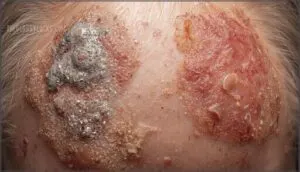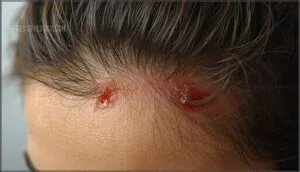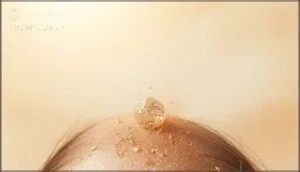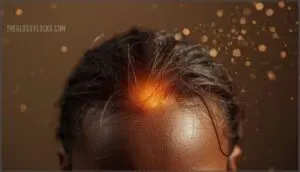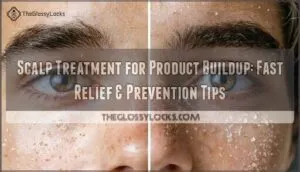This site is supported by our readers. We may earn a commission, at no cost to you, if you purchase through links.
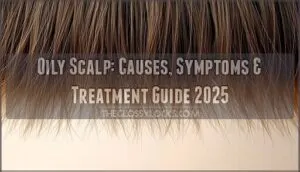 Your scalp produces enough oil each day to coat a smartphone screen—about 220 micrograms per square centimeter—but when that number climbs higher, your hair turns greasy within hours instead of days. This isn’t just about overwashing or the wrong shampoo; genetic variants, hormone surges, and even the humidity in your bedroom all dictate how much sebum your scalp churns out.
Your scalp produces enough oil each day to coat a smartphone screen—about 220 micrograms per square centimeter—but when that number climbs higher, your hair turns greasy within hours instead of days. This isn’t just about overwashing or the wrong shampoo; genetic variants, hormone surges, and even the humidity in your bedroom all dictate how much sebum your scalp churns out.
Some people inherit overactive sebaceous glands the same way they inherit eye color, while others watch their oil production spike during stress or summer heat.
Understanding what triggers excess sebum gives you the power to reclaim control, whether that means adjusting your product routine, targeting fungal overgrowth, or addressing hormonal imbalances at their source.
Table Of Contents
- Key Takeaways
- What Causes an Oily Scalp?
- Skin Conditions Linked to Oily Scalp
- Daily Habits That Worsen Oily Scalp
- Symptoms and Complications of Oily Scalp
- Effective Treatments for Oily Scalp
- Home Remedies and Prevention Tips
- Frequently Asked Questions (FAQs)
- Why is my scalp oily?
- What causes dry hair with an oily scalp?
- Can oily scalp cause hair loss?
- Why is my hair oily?
- Can oily hair irritate your scalp?
- Why do people with thick hair have oily scalp?
- Can oily scalp cause permanent hair thinning?
- How does diet affect sebum production rates?
- Are there genetic tests for oily scalp?
- Can exercise routines worsen scalp oiliness?
- Conclusion
Key Takeaways
- Your scalp can produce up to 220 micrograms of sebum per square centimeter daily, and when genetic variants, hormonal surges (especially androgens like testosterone and DHT), or environmental factors push that number higher, your hair turns greasy within hours—understanding these triggers lets you target the root cause instead of just masking symptoms.
- Overwashing strips natural oils and triggers rebound sebum production spikes of 10–20%, while underwashing lets oil oxidize and feeds fungal overgrowth up to 1,000-fold, so finding your ideal washing frequency (typically 2–6 times weekly) and using pH-balanced, sulfate-free products is critical for oil control.
- An oily scalp creates a breeding ground for Malassezia fungi and inflammation that leads to dandruff in up to 50% of adults, and chronic sebum buildup starves follicles of oxygen, shrinks hair diameter by 20–40%, and can cause permanent hair loss through follicle miniaturization if left untreated.
- Effective treatment combines targeted approaches—clarifying shampoos with salicylic acid or tea tree oil, medicated options like ketoconazole for fungal overgrowth, lifestyle changes (cutting refined carbs, adding omega-3s, managing stress), and addressing underlying conditions like PCOS or seborrheic dermatitis at their source.
What Causes an Oily Scalp?
Your scalp produces oil through sebaceous glands, but sometimes this natural process goes into overdrive.
Understanding what triggers excess oil production helps you take control and find the right solution.
Let’s look at the main culprits behind an oily scalp.
Overactive Sebaceous Glands
Your sebaceous glands—tiny oil factories embedded in your scalp—can shift into overdrive, pumping out excess sebum that leaves your hair looking slick and heavy. Adults normally produce about 1 mg of sebum per 10 cm² every three hours, but when gland regulation falters, that rate can spike to 1.5–4.0 mg, creating what dermatologists call hyperseborrhea.
Here’s what drives overactive sebaceous glands:
- Hormone influence from androgens like testosterone directly cranks up oil production rates, especially during puberty or hormonal shifts
- Your scalp hosts 400–900 sebaceous glands per cm²—the highest density anywhere on your body, making it prone to oiliness
- Scalp health management suffers when sebum levels climb above 220 μg/cm², triggering that greasy, uncomfortable feeling
- Excess oil production blocks follicles, starving hair roots of oxygen and potentially causing thinning
- Sebum buildup disrupts your scalp’s natural balance, creating an environment where bacteria and yeast thrive
Understanding the causes of hyperseborrhea involves studying seborrhea treatment options to address the root of the problem.
Genetics and Heredity
Your genetic blueprint—handed down from your parents—can lock you into lifelong oiliness before you even pick up a shampoo bottle. Genetic predisposition accounts for 40–60% of sebum variation, with families showing 2.3 times higher seborrhea risk when parents had oily scalps.
Inherited conditions involve SCD1 and Lrig1 gene variants that boost sebocyte proliferation, while familial patterns reveal 57% inheritance probability if one parent struggles with excess oil.
Gene expression differences affect sebaceous gland size, density, and androgen receptor sensitivity—all hereditary traits that magnify hormonal influences on hair and create lasting hormonal imbalance vulnerability. Understanding the role of scalp health factors is essential in addressing oily scalp issues.
Hormonal Fluctuations
While genes set the stage, hormones run the show—and they don’t play fair. Androgens, particularly testosterone and DHT, directly stimulate your sebaceous oil glands to pump out more oil. Puberty changes trigger sebum spikes of 200–300%, which explains teenage oiliness.
Women face hormonal fluctuations during menstrual cycles, with 21–28% more sebum in the luteal phase. PCOS, hormone therapy, and even stress-induced cortisol surges heighten androgen effects, creating hormonal imbalance that leaves your scalp slick.
Estrogen levels drop postpartum and at menopause, tipping the balance toward oilier skin.
Environmental Factors (Humidity, Heat)
Your surroundings matter more than you think. High humidity triggers your scalp to overproduce oil—sebum excretion jumps about 10% for every 1°C rise in skin temperature. Hot, sticky environments create a perfect storm where sweat mixes with oil, clogging pores and fueling dandruff.
- Humidity above 60% disrupts your scalp’s barrier and ramps up greasiness
- Heat exposure from weather or heat tools without a heat protectant spray escalates oil output
- Seasonal variations mean summer brings up to 30% more oily scalp cases in humid climates
- Climate impact is real—tropical regions report 50% higher incidence than temperate zones
Temperature control and environmental factors for hair health aren’t optional if you want balanced scalp health.
Stress and Lifestyle Choices
Chronic stress doesn’t just weigh on your mind—it hijacks your scalp health. Elevated cortisol levels can spike sebum production by up to 45%, turning your hair greasy within days.
Poor sleep patterns under six hours nightly raise oil output by 20–30%, while dietary habits heavy in saturated fats increase greasiness by 40%.
Substance abuse, including smoking and alcohol, disrupts nutrient absorption and oxygen delivery, worsening scalp oiliness.
An exercise routine with moderate activity stabilizes cortisol and cuts excess sebum by roughly 22%, proving that managing oily scalp starts with lifestyle choices and consistent hair care.
Skin Conditions Linked to Oily Scalp
An oily scalp doesn’t just happen on its own—sometimes specific skin conditions are driving the excess oil production. Certain dermatological issues affect your scalp’s oil glands directly, creating a cycle of inflammation and greasiness that won’t quit.
Let’s look at the most common conditions that can turn your scalp into an oil factory.
Seborrheic Dermatitis
Seborrheic dermatitis is a chronic skin condition that triggers inflammation and excessive oil production on your scalp. This disorder affects around 5.64% of adults globally and causes red, scaly patches, persistent dandruff, and intense itching.
Your skin microbiome and immune response play key roles in seborrheic dermatitis management, making proper scalp health maintenance essential to control these uncomfortable flare-ups.
Scalp Psoriasis and Eczema
Psoriasis and eczema turn your scalp into a battleground where your immune response misfires, creating inflamed patches and disrupting your skin barrier. Around 80% of psoriasis patients experience scalp involvement, while seborrheic dermatitis—a type of scalp eczema—affects roughly 4% of adults worldwide.
Key factors triggering these skin conditions:
- Stress, infections, and medications provoke psoriasis triggers that worsen scalp inflammation
- Environmental irritants and hormonal shifts compromise your skin barrier function
- Genetic variants increase your susceptibility when family members have these conditions
- Both disorders cause thick scales, redness, and itching that demand targeted eczema management strategies
Proper scalp health requires controlling these triggers while addressing the underlying immune dysfunction.
Scalp Yeast Infections
Yeast infection on your scalp thrives when Malassezia fungi multiply beyond normal levels, feeding on excess sebum and disrupting your scalp health. Over 50% of dandruff cases in dermatology clinics show Malassezia isolates, and males aged 20 to 30 face the highest risk.
You’ll notice itchy, flaky patches and white pimples as fungal buildup damages follicles. Antifungal therapy combining topical and oral treatments clears infection rapidly, while medicated shampoos prevent recurrence and support infection prevention.
Daily Habits That Worsen Oily Scalp
You might be making your oily scalp worse without realizing it. Certain everyday habits strip your scalp’s natural balance or trap excess oil, triggering your glands to overproduce sebum.
Let’s look at the most common culprits that keep your scalp greasy.
Overwashing or Underwashing Hair
Finding your ideal hair washing frequency takes trial and error—too much or too little both backfire on scalp pH balance and sebum regulation. Overwashing strips natural oils, prompting your glands to overproduce by 10–20%, while underwashing lets sebum oxidize, creating irritants that spike oxidative stress by over 50%.
Here’s what happens with poor shampooing habits:
- Overwashing disrupts your scalp microbiome and weakens the protective barrier
- Underwashing increases Malassezia fungi growth up to 1,000-fold in some cases
- Daily washing can reduce surface lipids by 40% but may trigger rebound oil production
- Washing fewer than twice weekly triples scalp odor intensity and worsens dandruff
Most people find their sweet spot at 2–6 washes weekly, depending on natural oil production control needs.
Using Harsh Hair Products
Your hair products might be sabotaging your scalp—up to 72% of people using sulfate-based shampoos report worse oiliness. Harsh shampoo effects include stripping natural oils, which triggers reactive sebum surges of 21% within a week.
Product ingredient risks like sodium lauryl sulfate disrupt your scalp’s barrier, while silicones and preservatives cause buildup and inflammation.
Switching to gentle product alternatives with balanced pH can cut excess oil by 44% in four weeks.
Poor Hairbrush and Accessory Hygiene
Your hairbrush might be a breeding ground—studies show that contaminated tools harbor bacteria and fungi in up to 54% of cases. When you skip regular accessory cleaning, you’re redistributing oxidized sebum, product residue, and microbes back onto your scalp with every stroke.
This microbial transmission triggers scalp irritation and fungal overgrowth, worsening oiliness by up to 40% and sabotaging your entire hair care routine.
Heat Styling and Product Buildup
Blow-dryers and styling tools don’t just damage hair texture—direct heat exposure opens pores and triggers a rebound effect, causing your sebaceous glands to overproduce oil by nearly 30%.
Meanwhile, mousses, gels, and leave-in products coat your scalp with residue that clogs follicles and disrupts oil balance.
When you combine heat styling with heavy hair products, you’re creating a greasy film that spreads faster and sticks longer, sabotaging your hair care routine and scalp care for oily hair goals within hours.
Symptoms and Complications of Oily Scalp
An oily scalp doesn’t just make your hair look greasy—it can trigger a cascade of uncomfortable symptoms that affect both your appearance and scalp health. Left unchecked, excess sebum creates an environment where irritation, inflammation, and even hair loss can take root.
Here’s what you need to watch for and why these warning signs matter.
Greasy or Heavy Hair
When your hair turns slick just hours after shampooing, you’re dealing with excess sebum production that spreads across hair shafts fast—studies show greasiness appears within 24 hours on oily scalps. This oily scalp condition creates visible signs:
- Hair looks shiny and wet, even when completely dry
- Strands clump together and feel heavy or weighed down
- Your hair texture management routine fails as styling products slide off greasy hair
Sebum production above 2.5 mg per 3 hours signals hyperseborrhea, making oil control methods essential for scalp health and better hair care tips.
Itchy, Red, or Flaky Scalp
Beyond the greasy surface, your scalp rebels with irritation—up to 97% of people with scalp psoriasis report intense itching. Flaky patches appear when inflammation disrupts your skin barrier, and seborrheic dermatitis creates redness, posing treatment challenges for 3–5% of the global population. Here’s what an itchy scalp signals:
| Symptom | What It Means |
|---|---|
| Persistent scratching | Scalp inflammation damages your skin barrier |
| Red, scaly patches | Skin inflammation from seborrheic dermatitis or psoriasis |
| White or yellow flakes | Dandruff from fungal overgrowth and excess oil |
| Crusty sores | Secondary infections from broken skin |
| Burning sensation | Active inflammatory response needs immediate attention |
Take control—these symptoms won’t vanish without targeted intervention.
Dandruff and Scalp Inflammation
An oily scalp creates the perfect storm—dandruff thrives when excess sebum feeds Malassezia fungi, triggering inflammation in up to 50% of adults worldwide. Seborrheic dermatitis develops as these microbes release irritating fatty acids, disrupting your scalp microbiome and barrier function.
You’ll notice white flakes, redness, and relentless itching as your immune system wages war against fungal overgrowth.
Dandruff prevention starts with understanding inflammation causes—addressing both oil production and scalp health breaks this cycle before fungal infections take deeper hold.
Hair Loss and Follicle Damage
Chronic sebum buildup doesn’t just make your hair look greasy—it starves follicles of oxygen and nutrients, triggering follicle miniaturization that shrinks hair diameter by 20–40%. You’ll experience progressive hair thinning as excess oil traps DHT near follicles, shortening growth cycles by 22–35% faster than normal.
Scalp inflammation and follicle degeneration accelerate when oily buildup feeds bacterial overgrowth, causing perifollicular fibrosis that damages follicle structure in over 60% of chronic cases.
Addressing sebum production regulation early prevents irreversible follicle damage and hair loss.
Effective Treatments for Oily Scalp
Treating an oily scalp isn’t about harsh measures—it’s about finding what works for your specific situation. The right approach combines smart product choices, targeted treatments, and addressing any underlying issues that fuel excess oil.
Here’s what you need to know to take control.
Choosing The Right Shampoo and Conditioner
Your shampoo choice can make or break your scalp’s oil balance. Look for clarifying shampoos with salicylic acid or tea tree oil—these remove excess sebum without stripping your scalp dry. pH-balanced formulas between 4.5 and 5.0 keep your scalp’s protective barrier intact, reducing irritation by about 32%. Choose amphoteric surfactants over harsh sulfates to cut irritation risk nearly in half.
For conditioner, go silicone-free—silicone buildup increases greasiness by 29% and weighs hair down, making oily scalp worse.
Medicated and Prescription Treatments
When over-the-counter products don’t cut it, prescription shampoos step in. Ketoconazole 1-2% targets fungal overgrowth and inflammation, clearing symptoms in 2-4 weeks. Selenium sulfide 2.5% controls sebum production directly.
For stubborn cases, your dermatologist might prescribe topical corticosteroids or anti-inflammatory scalp serums.
Severe oily scalp? Oral isotretinoin shrinks sebaceous glands by up to 90%. These medical treatments work—you just need the right one.
Scalp Exfoliation and Clarifying Products
You can break the grip of oil buildup with the right tools. Scalp scrubs lift away dead cells and sebum—a 15-day regimen cut flaking by 61% and boosted scalp hydration by 76%.
Use clarifying shampoo weekly or biweekly to strip product residue without overdoing it. Choose gentle exfoliants with salicylic acid for precision targeting.
Managing Underlying Medical Conditions
Your scalp doesn’t exist in a vacuum—hormonal fluctuations, immune dysfunction, and metabolic disorders directly fuel excess oil. If you have PCOS, eczema, psoriasis, or insulin resistance, targeted healthcare options matter.
Medical diagnosis uncovers root causes, and treatment plans—from hormone therapy to antifungal prescriptions—address disease management at the source. Skin conditions demand specialized care, not just surface fixes.
Home Remedies and Prevention Tips
You can take control of your oily scalp without relying solely on products or prescriptions.
Simple adjustments to your daily routine, combined with targeted natural remedies, can make a real difference.
Here’s what works based on evidence and clinical experience.
Diet and Lifestyle Modifications
Often, your nutrition planning and balanced diet choices hold more power over your oily scalp than you’d expect. What you eat—and how you manage stress—directly impacts sebum production and scalp health. Here’s how lifestyle changes make a difference:
- Cut refined carbs and sugar: They spike insulin and trigger up to 30% more scalp oil through androgen stimulation.
- Add omega-3s: Fish, walnuts, and flaxseed calm inflammation and regulate sebum output naturally.
- Hydrate properly: At least 2 liters daily prevents compensatory oil overproduction from dehydration.
- Choose lean proteins and fiber: Stabilize hormones and support healthy hair follicles without excess grease.
- Exercise regularly: Moderate aerobic activity improves oily scalp symptoms by nearly 15% in six months while reducing stress-driven sebum spikes.
These healthy habits form the foundation of effective hair care and stress management for long-term scalp control.
Natural Remedies (Aloe Vera, Tea Tree Oil, ACV)
Beyond diet tweaks, three natural remedies—aloe vera, tea tree oil, and apple cider vinegar—offer scientifically backed results you can use at home. Aloe vera’s enzymes break down sebum by up to 40%, tea tree oil cuts dandruff by 78.6% and regulates oil secretion, while diluted ACV maintains scalp pH at 4.5–5.5 to prevent overproduction.
| Remedy | Key Action | Best Use |
|---|---|---|
| Aloe Vera Benefits | Reduces inflammation, breaks down fats | Apply gel 10–20 min twice weekly |
| Tea Tree Oil | Antifungal, astringent sebum control | 2–5% shampoo or diluted mask |
| ACV Remedies | Balances pH, antimicrobial rinse | 1:3 dilution, weekly post-wash rinse |
Combine them thoughtfully—aloe with tea tree boosts antifungal action, while ACV before aloe amplifies sebum control by 20–25%. These herbal treatments for natural scalp care work best when diluted properly and applied consistently.
Hair Washing Techniques and Frequency
Your hair washing routine controls oil better than any product alone. Wash oily scalps daily or every other day—70-80% find this timing effective—and focus shampoo directly on your scalp with a gentle massage to lift sebum without triggering rebound production.
Use lukewarm water around 100°F to cleanse without stripping natural oils, then rinse thoroughly to prevent residue buildup that mimics greasiness.
Preventing Product and Oil Buildup
Proper scalp hygiene doesn’t end with washing—buildup prevention keeps your scalp truly oil-free. Studies show clarifying shampoos twice monthly remove up to 90% more residue than daily products, while weekly brush cleaning cuts bacterial redeposition by 70%.
- Use clarifying shampoos biweekly to strip product layers without daily scalp stress
- Wash hair after workouts to eliminate sweat-salt accumulation (reduces buildup 35%)
- Clean hairbrushes weekly with warm soapy water to prevent oil transfer
- Apply leave-in products only after hair dries—post-dry application halves residue persistence compared to wet-scalp layering
Frequently Asked Questions (FAQs)
Why is my scalp oily?
You’ve heard “the root of the problem runs deep”—and with oily scalp, that’s literally true. Your sebaceous glands produce excess sebum, coating hair follicles and disrupting scalp health when hormone balance shifts or oil production increases beyond normal levels.
What causes dry hair with an oily scalp?
Overactive sebaceous glands pump out excess sebum at the roots, but damaged or chemically treated hair can’t pull that oil down the shaft.
You’re left with greasy roots and parched ends—a mismatch in oil balance and hair structure.
Can oily scalp cause hair loss?
Yes, an oily scalp can contribute to hair loss. Excess sebum promotes microbial overgrowth and scalp inflammation, which damages hair follicles over time.
This chronic irritation triggers oxidative stress and follicle miniaturization, ultimately leading to thinning and shedding.
Why is my hair oily?
Your hair gets oily when sebaceous glands in your scalp produce excess sebum—a natural oil that protects hair follicles and maintains scalp health.
Genetics, hormone balance, stress, and environmental factors all influence oil production rates, which can range from 25 to over 220 μg/cm²/hr.
Can oily hair irritate your scalp?
Absolutely—excess sebum doesn’t just sit on your scalp harmlessly. When oil accumulates, it creates a breeding ground for microbial overgrowth, triggering inflammation and irritation.
Studies show oily scalps experience a 25-30% increase in transepidermal water loss, compromising your scalp’s protective barrier and leaving hair follicles vulnerable to damage, itching, and dandruff.
Why do people with thick hair have oily scalp?
Thick hair correlates with higher hair follicle density—around 100 glands per square centimeter—which means more sebaceous glands actively producing sebum.
This increased gland concentration, combined with thick hair’s larger surface area trapping oils and slowing drying times, creates the perfect storm for scalp oiliness.
Can oily scalp cause permanent hair thinning?
Up to 5% of people develop seborrheic dermatitis, a scalp condition linked to hair thinning. Yes, an oily scalp can cause permanent hair loss through follicle miniaturization and oxidative stress, but only if scalp inflammation and sebum damage persist untreated, destroying hair follicles and preventing hair regeneration.
How does diet affect sebum production rates?
Your diet directly impacts oil production through several key mechanisms. High glycemic index foods and refined carbs spike insulin levels, which trigger sebaceous glands to produce more sebum.
Dairy consumption can also increase oiliness by introducing hormones that stimulate oil production.
Meanwhile, omega fatty acids help regulate sebum output—a balanced diet promotes healthier scalp function.
Are there genetic tests for oily scalp?
Wondering if your DNA holds the answer to your greasy roots? Right now, there aren’t any commercial genetic tests available specifically for oily scalp, despite research identifying sebum gene markers and genetic factors in hair oil production.
Scientists use sophisticated scalp microbiome analysis and study genetic predisposition, but these remain research tools—not clinical tests you can order.
Can exercise routines worsen scalp oiliness?
Yes, exercise routines can worsen scalp oiliness. Hormones like androgens increase during workouts, boosting sebum production by 20-30%.
Sweat mixes with scalp oils, creating a greasy environment that promotes inflammation and microbial growth—especially without proper post-exercise hygiene and hair washing.
Conclusion
An ounce of prevention beats a pound of cure—and nowhere is that truer than when tackling the causes of oily scalp and treatment options that actually work. You’ve seen how genes, hormones, and daily habits conspire to turn your roots slick, but you’ve also learned that targeted shampoos, scalp exfoliation, and lifestyle tweaks can dial down sebum production.
Don’t let an overactive scalp write your story; armed with this guide, you can reclaim balance and confidence.
- https://headandshoulders.com/en-us/healthy-hair-and-scalp/hair-care/is-there-a-genetic-link-to-greasy-hair
- https://ufhealth.org/conditions-and-treatments/oily-hair
- https://nypost.com/2025/08/27/health/how-to-fix-an-oily-scalp-it-could-be-a-sign-of-future-hair-loss/
- https://pmc.ncbi.nlm.nih.gov/articles/PMC11846515/
- https://juicychemistry.com/blogs/hair-care/oily-hair-causes-prevention-and-remedy

